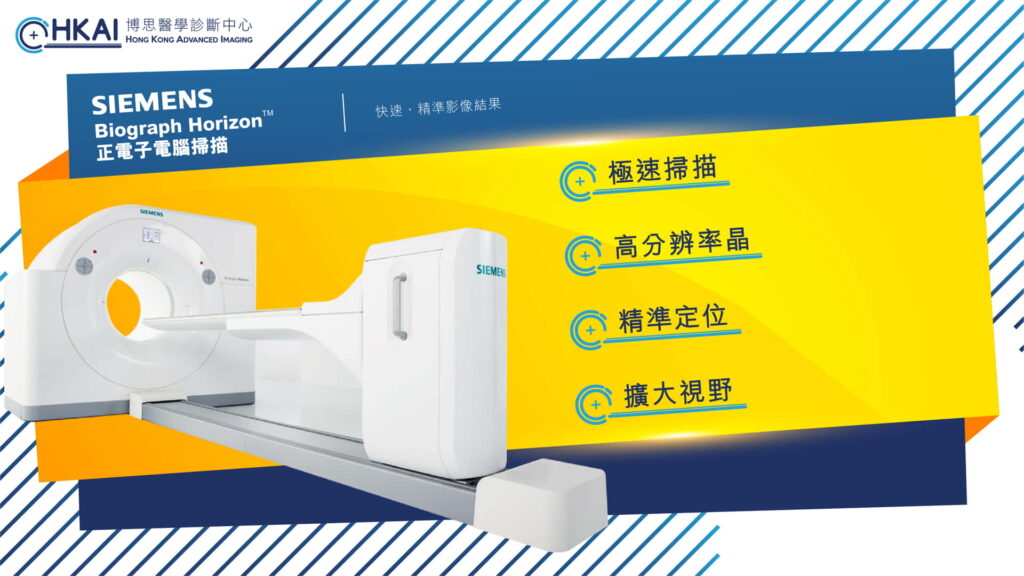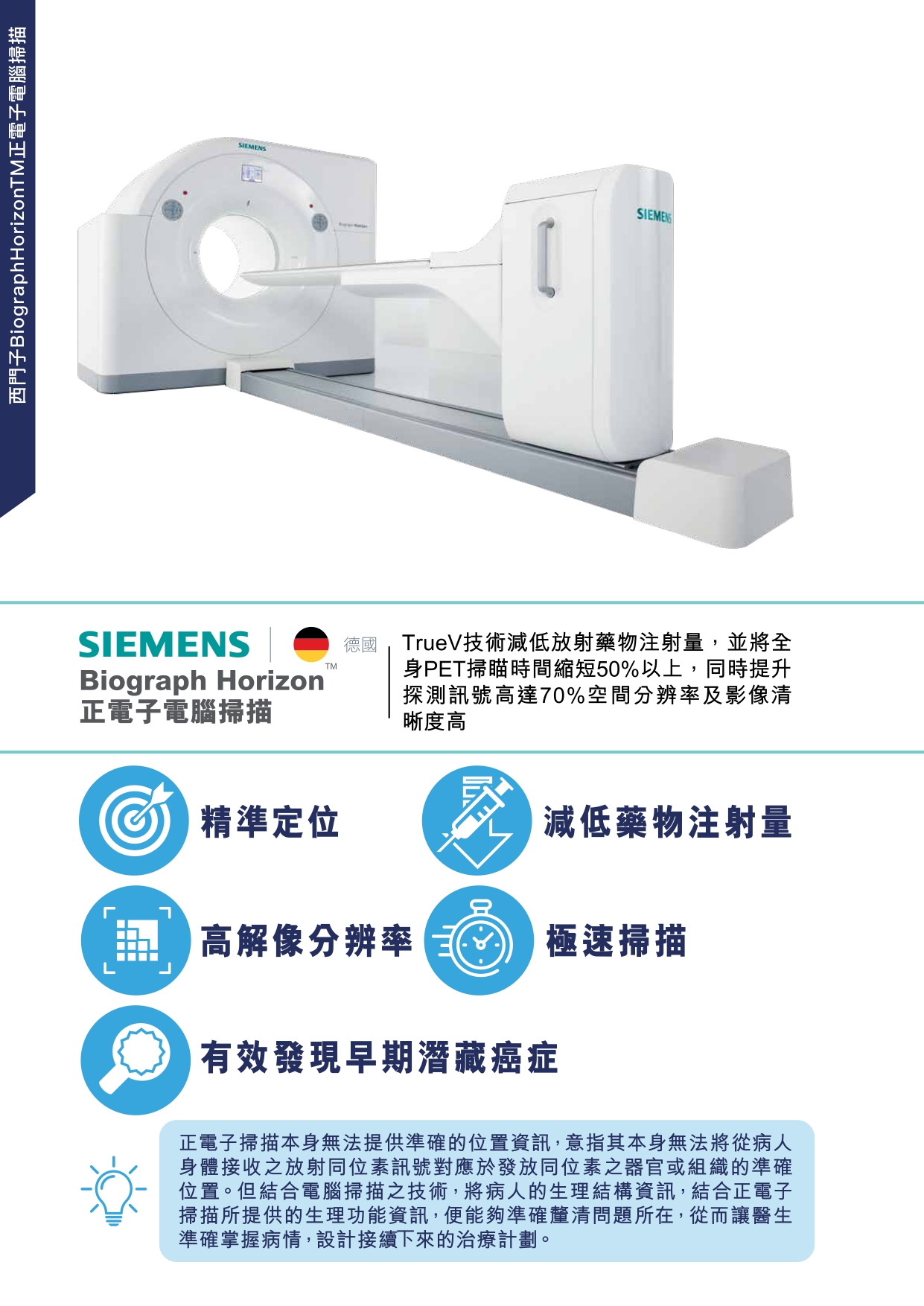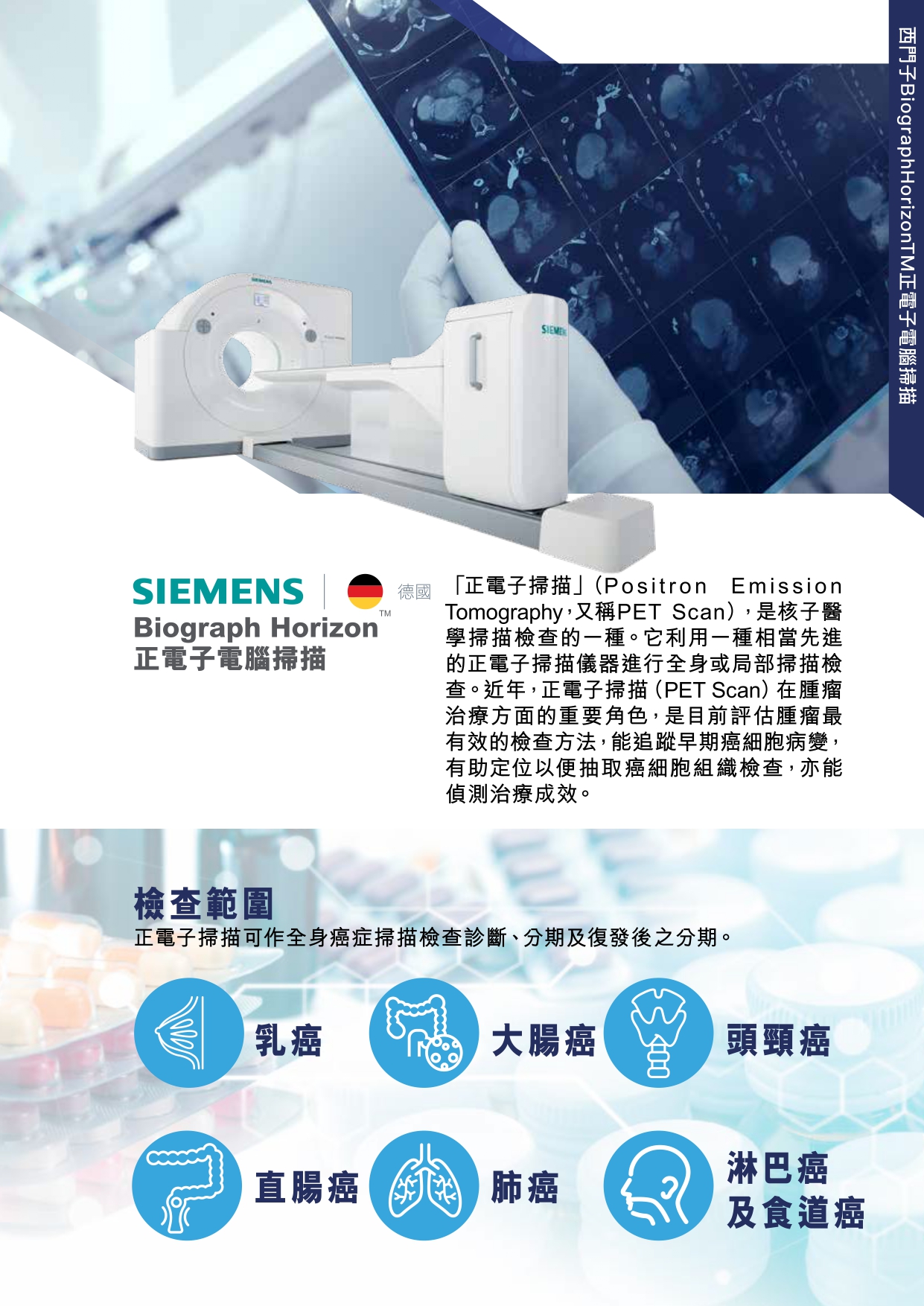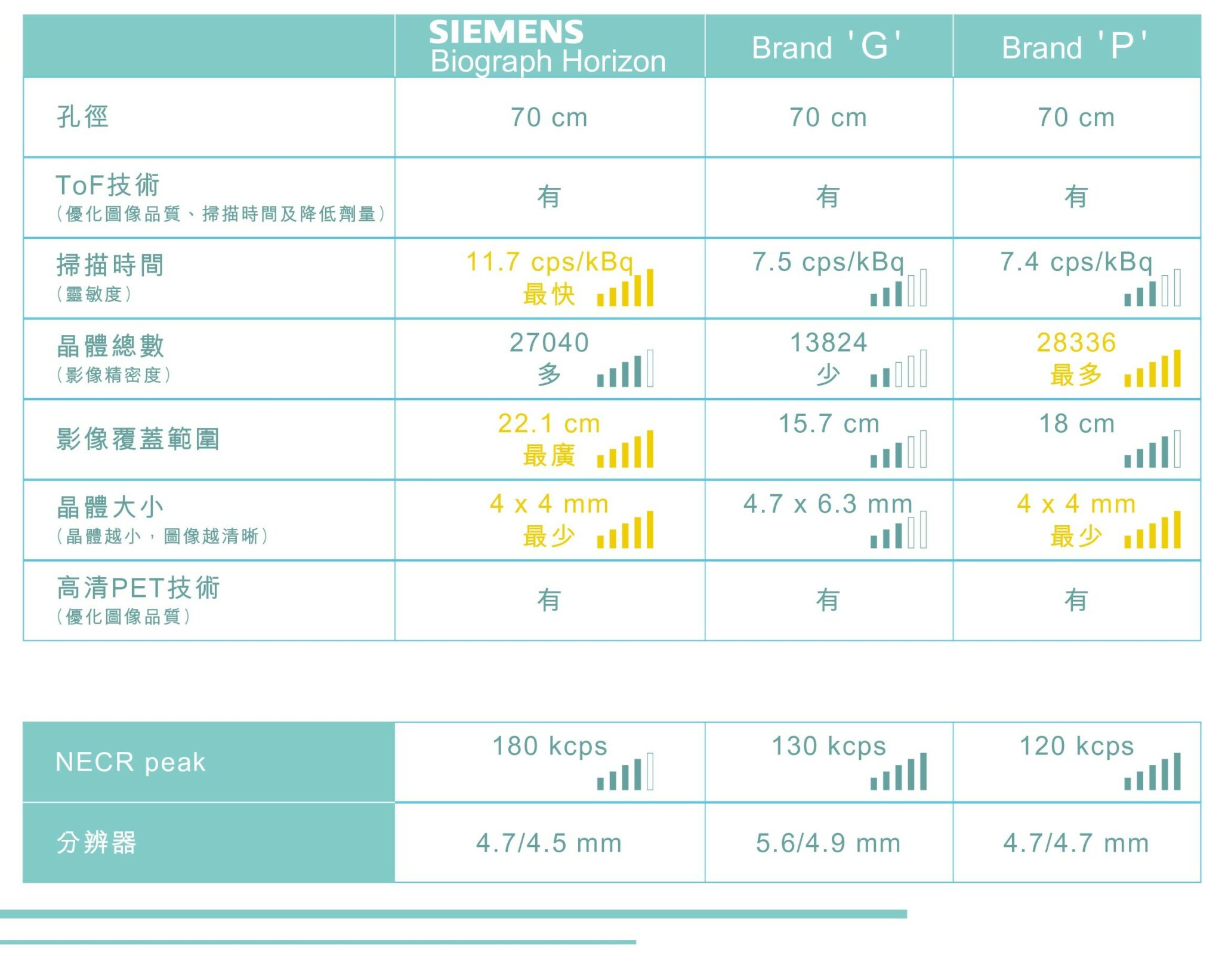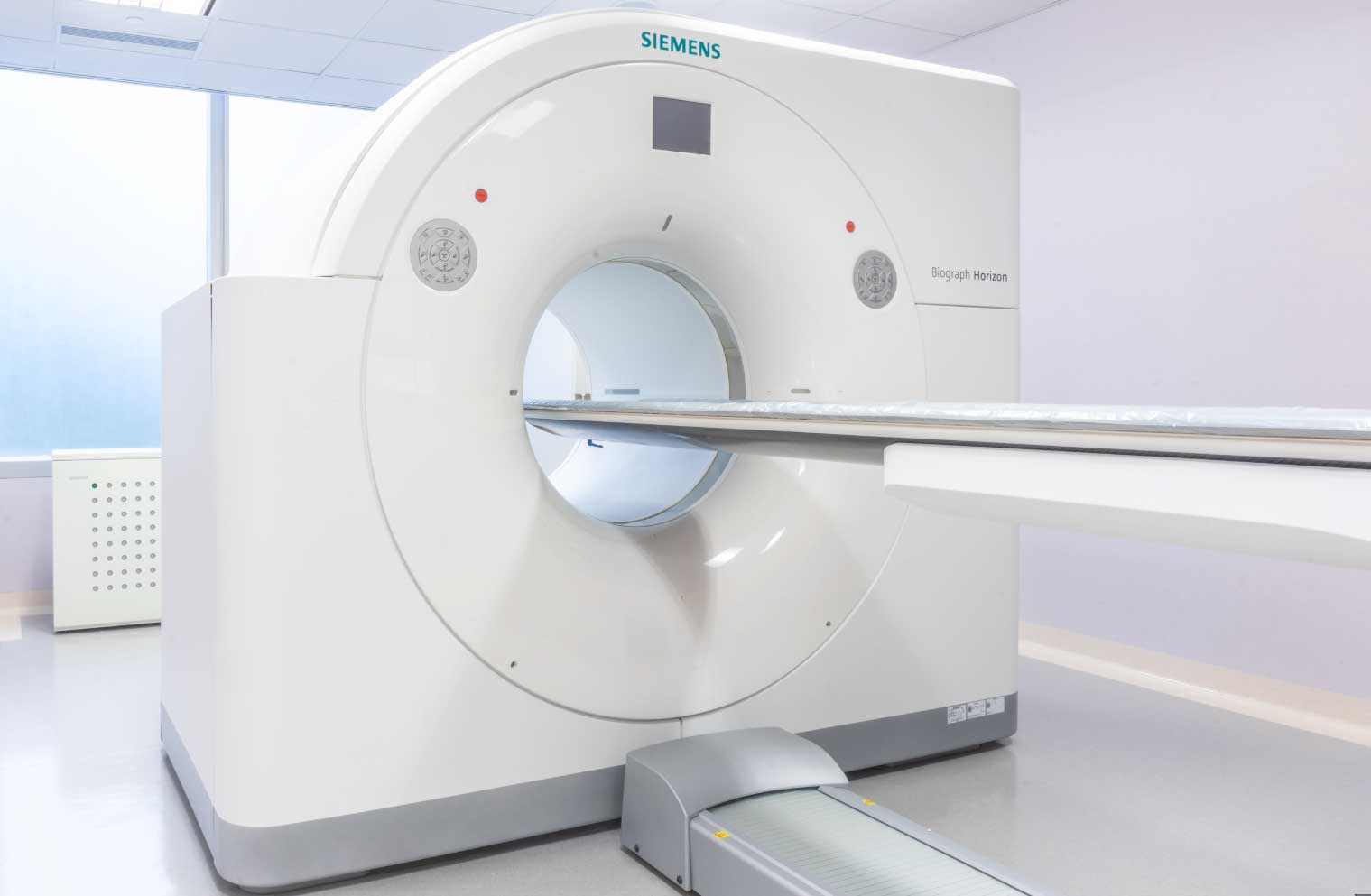
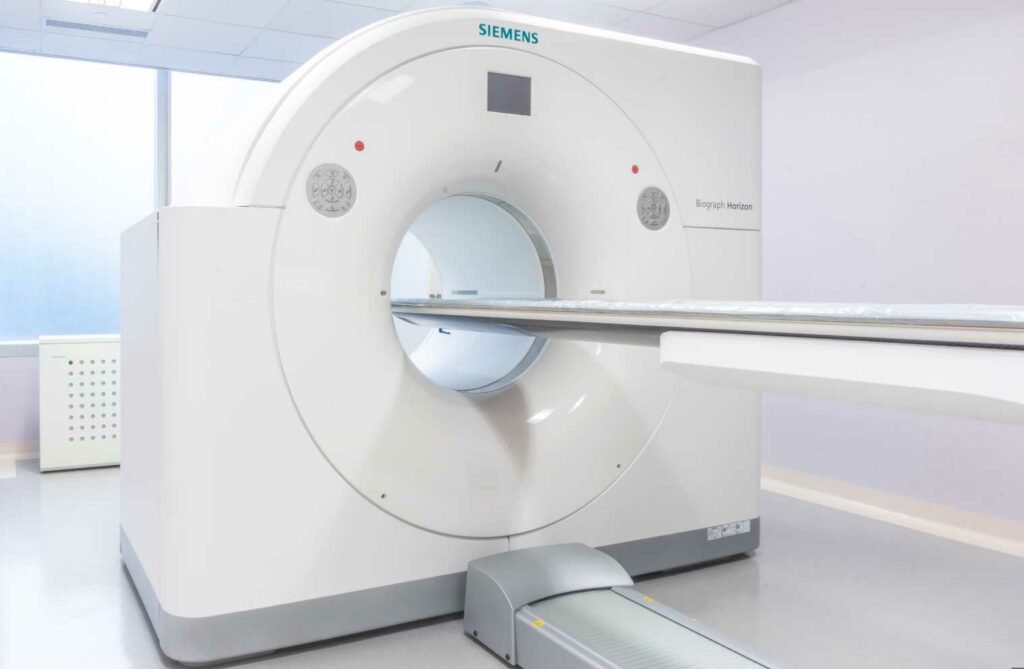
Contact Us
Positron Emission Tomography-Computed Tomography (PET-CT Scan)
Positron Emission Tomography-Computed Tomography (PET-CT Scan) is a combination of PET and CT technology. It can be used to evaluate and diagnose cancer, malignant tumour, neurological disorders, cardiovascular diseases, etc. The entire PET-CT scan procedure takes approximately 3-4 hours. Contact us for more details on the cost and points to note of the procedure.

PET-CT Scan Siemens Biograph Horizon Siemens Biograph Horizon PET-CT Scan
PET-CT is currently the primary functional non-invasive examination. It combines CT technology to detect tumours and diagnose diseases in the brain and heart. It helps doctors to distinguish between living and dead tissue, as well as the growth of benign or malignant tumours/cancer. Thus, doctors can make the most appropriate treatment recommendations for patients.
The Siemens Biograph Horizon™ PET/CT scanners used in HKAI treatments provide fast and accurate imaging outcomes. The premium LSO-based scintillation crystals in the detectors developed by Siemens have been upgraded from 6.3mm to 4.00mm compared to the previous BGO-based PET/CT scanners for better image clarity. Moreover, the LSO scintillation crystals have significantly improved their signal-to-noise ratio and reduced the scanning time required. This, together with Siemens SAFIRE’s exclusive technology, reduces the radiation dose to patients by up to 60%.
What is Positron Emission Tomography-Computed Tomography (PET-CT Scan)?
Positron Emission Tomography-Computed Tomography (PET-CT Scan) is a functional imaging test that offers detailed information about a particular body organ or specific function of the body. It is commonly used to evaluate and diagnose cancer, neurological disorders of the brain, and cardiovascular disease. PET-CT scan can detect cancer earlier than other imaging procedures such as CT and MRI scans, it allows doctors to determine if and where the cancer is spreading to other parts of the body. Prior to the scan, a radiologist will inject radiopharmaceutical into the patient’s body. During the scan, the medical staff will inject a radioactive tracer into the patient’s body, a PET scanner is used to capture images of the patient’s body. The specialised camera can detect the radiation emitted by the radioisotope, and a multidimensional image of the examined area will be constructed by computer. The radiopharmaceutical usually accumulates in the cancerous tissue rather than in healthy tissue.
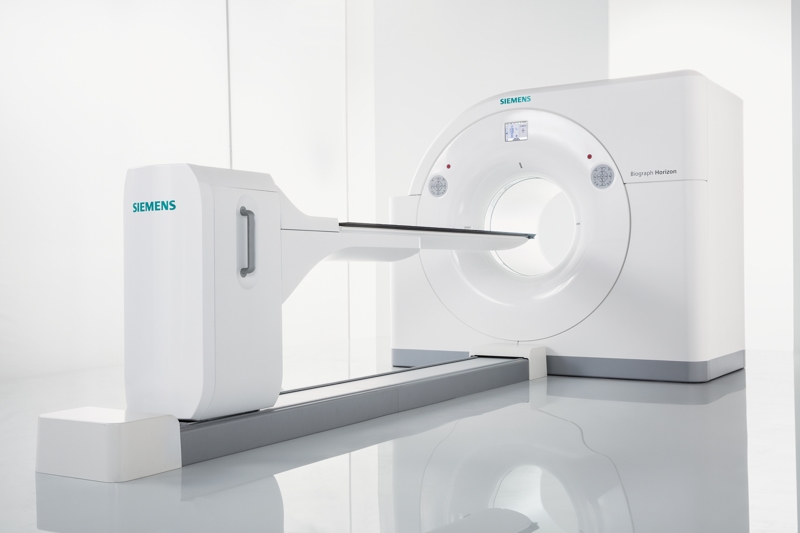
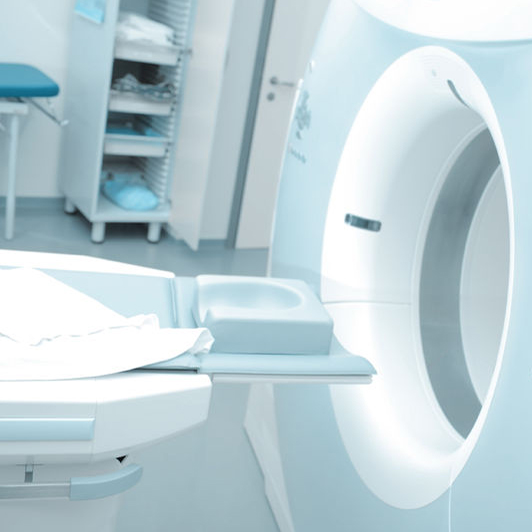
Leveraging the Combined Strength
PET Scan is one of the most effective ways of cancer screening. It can examine the entire body to detect hidden cancers, distinguish benign and malignant tumours with over 90% of accuracy, assess the efficacy of cancer treatments, identify tumours recurrence and necrosis, and locate radiotherapy focus target area. The cancer cells that have spread to the other parts can be detected by PET scan as malignant tumours, as they exhibit symptoms of excessive glucose consumption. Accurate staging of cancer can help to develop an appropriate treatment, so as to increase the chances of recovery. PET-CT combines the advantages of conventional PET (Positron Emission Tomography) and CT (Computed Tomography). It can detect the presence and metastasis, and pinpoint precisely the location of cancer cells through CT.
PET Scan Procedures
The entire PET-CT scan procedure takes approximately 3-4 hours. It includes pre-injection screening, measurement of fasting plasma glucose, and radiopharmaceutical injection. The patient has to lie still after the injection for about 1 hour to wait for the drug to be absorbed, followed by a full body scan (about 30 minutes). The patient will take another 1-1.5 hours of rest for the attenuation and metabolism of medication. Under certain circumstances, the patient will undergo another scanning procedure during this period.
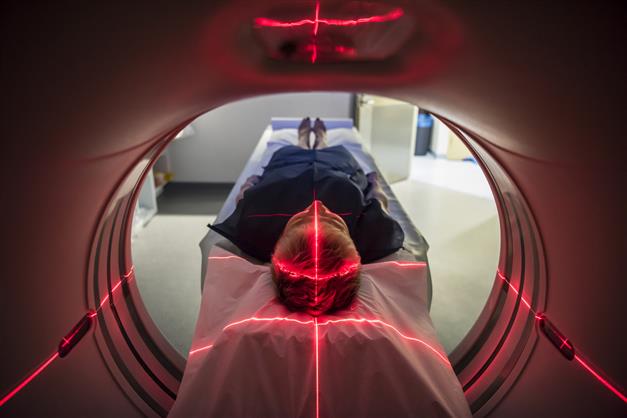
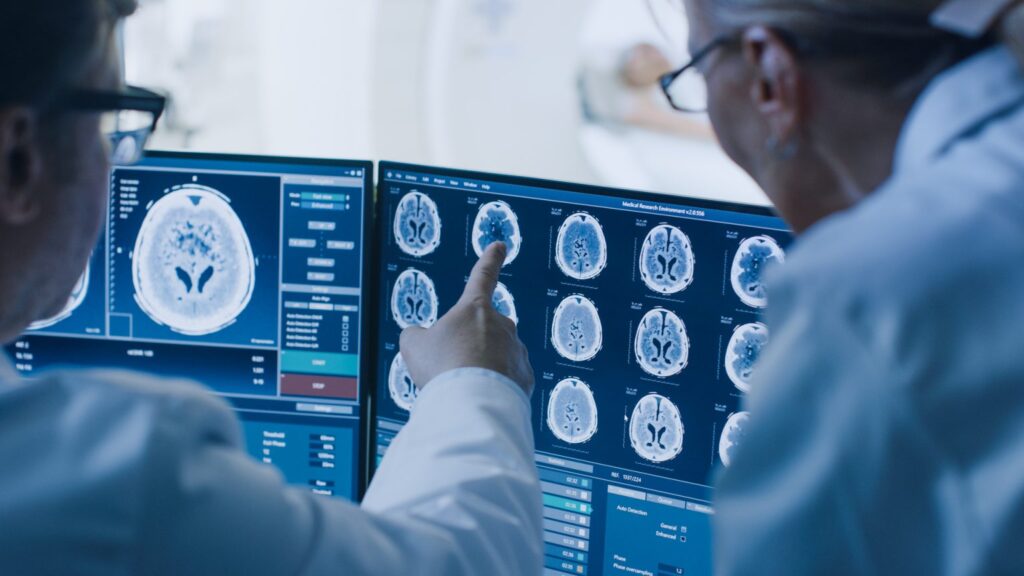
Points to Note
Please inform our medical staff if:
- Patients should not have undergone any barium x-ray examination 10 days prior to the PET-CT scan.
- A 6-hour fasting is required prior to the scan. Consumption of alcohol and beverages is prohibited (except water). Avoid medication with high sugar content (e.g. cough syrup, glucose). Avoid chewing gum or candy.
- A bland and easy-to-digest diet is recommended 1 day prior to the scan.
- Patients are advised to drink enough water, at least 6 to 8 cups of water 1 day prior to the scan.
- Avoid intense muscular activities such as strenuous exercise and heavy lifting.
- Pregnant and lactating women, people with unstable emotions, people with acutely persistent muscle cramps, and diabetic patients with poor blood sugar control should not be screened.
Guidelines for Patients with Diabetes
- Your appointment will be arranged in the morning as your blood sugar level will be lower at that time.
- Please follow your regular insulin and oral antidiabetic drugs instruction the day before the test. Fasting is required after midnight (except for water and non-glucose medication intake)
- Please do not inject insulin or take oral antidiabetic drugs on the day of examination.
- Patients are advised to eat right after the screening. You are recommended to have a half dose of IV insulin or a normal dosage of oral antidiabetic drugs during the meal after the scanning to avoid the risk of low blood sugar.
PET-CT service is available in the following centres:
Langham Place Flagship Centre
L12, Langham Place Office Tower, 8 Argyle Street, Mong Kok, Hong Kong (Mongkok MTR Exit E1)
L12, Langham Place Office Tower, 8 Argyle Street, Mong Kok (Mong Kok station Exit E1)
PET-CT Scan Q&A
A PET scan is an advanced imaging examination that offers detailed information on a particular body organ or specific function of the body. It is commonly used to evaluate and diagnose cancer, neurological disorders of the brain, and cardiovascular disease.
During the PET scan, a radiologist will inject a radioactive tracer into the patient’s body and images of the patient’s body are recorded with a PET scanner. A specialised camera can detect the radiation emitted by the radioactive tracer, and a multidimensional image of the examined area will be generated by the computer.
Positron Emission Tomography (PET Scan) is a form of nuclear medicine imaging. The biggest difference between a PET scan and the CT/MRI scan is their focus: the former measures metabolic activity while the latter create detailed images of the organs and tissues. Patients need to be injected with radioactive tracers (usually glucose) which will collect in tumours, inflamed areas or infections for doctors to see. If we use the analogy of photography, PET scan is like an infra-red camera while CT scan a high-definition camera. The current PET-CT scan adopted by many cancer patients combines the functional strength of PET and the structural focus of CT, hence making PET-CT a comprehensive screening. It is recommended that patients should seek medical advice from their doctor in view of the clinical signs and symptoms, so as to determine the best diagnosis.
PET scans are used to detect and monitor conditions such as cancers, neurological disorders of the brain, and cardiovascular diseases. They can detect cancers before the conditions become detectable with other imaging techniques such as CT and MRI scans. PET scans also allow doctors to determine if and where cancer is spreading to other parts of the body.
PET scans can show which part of the brain is responsible for epileptic seizures, which can help doctors to develop surgery for epilepsy. It is also used to assess Alzheimer’s disease and Parkinson's disease. The images produced can pinpoint areas of the brain that are not functioning properly. Early detection of neurological disorders facilitates more effective treatment.
- Patients should not have undergone any barium x-ray examination 10 days prior to the PET-CT scan.
- A 6-hour fasting is required prior to the scan. Consumption of alcohol and beverages is prohibited (except water). Avoid medication with high sugar content (e.g. cough syrup, glucose). Avoid chewing gum or candy.
- A bland and easy-to-digest diet is recommended 1 day prior to the scan.
- Patients are advised to drink enough water, at least 6 to 8 cups of water 1 day prior to the scan.
- Avoid intense muscular activities such as strenuous exercise and heavy lifting.
- Pregnant and lactating women, people with unstable emotions, people with acutely persistent muscle cramps, and diabetic patients with poor blood sugar control should not be screened.
The radiopharmaceutical (also known as a tracer) is injected into the patient's body prior to the scan. The radiotracers usually accumulate in diseased tissues more than in healthy tissues. The images of the body are then acquired by a gamma camera in the PET scanner. The camera detects the positrons emitted from the tracers in the body, and a multi-dimensional image of the examined body part will eventually be generated by the computer. The patient has to lie still after the injection for about 1 hour to wait for the drug to be absorbed, followed by a full body scan (about 30 minutes). The patient will take another 1-1.5 hours of rest as the radiotracer becomes less radioactive over time. The risk of having side effects is low.
PET scans are rarely recommended for pregnant and breastfeeding women.
Children are more susceptible to radiation than adults and are not suitable for PET scanning.

